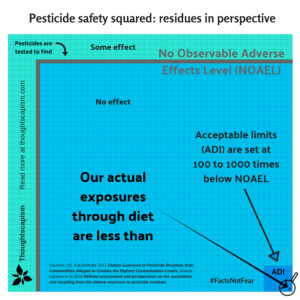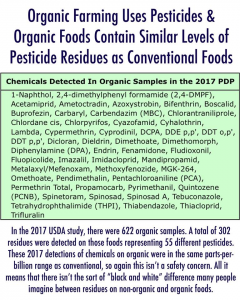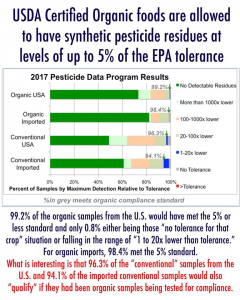The EPA defines the term “pesticide” as “Any substance or mixture of substances intended for preventing, destroying, repelling, or mitigating any pest, use as a plant regulator, defoliant, or desiccant, or use as a nitrogen stabilizer.” Pesticides are necessary to help farmers to use land and water more efficiently and enable us to enjoy a larger variety of foods with better quality. However, pesticide residues do make it into our foods, and consumers are concerned. Some organizations take advantage of this concern and perpetuate false information. So, what’s true and what isn’t?
Myth #1: Pesticides are toxic. There’s no safe level in foods.
Truth: First off, if anyone tells you that a food is “toxic” or “poisonous” without telling you what the chemical is that they’re referring to, the dose that is toxic, and the concentration in which it occurs in the food, they either have no idea what they’re talking about, are trying to sell you something, and/or are trying to deceive you. There are not “toxic chemicals,” only toxic doses. Everything can be toxic at a large enough dose, even water and salt. This is what we mean when we say “the dose makes the poison.” The mere presence of a chemical in a food doesn’t mean it’s unsafe or harmful. My favorite example is formaldehyde, which can be harmful to humans at high doses, yet our bodies produce formaldehyde as a normal part of our metabolism, and it’s naturally found in foods such as apples and pears at safe levels. By the same logic there are safe levels of pesticide residues in foods as well. Not to mention the fact that 99.99 percent of the pesticides we consume are produced by the plants themselves!
Myth #2: Pesticides aren’t tested for safety. We have no idea what the safe levels are or how much is in our foods.
Truth: The Environmental Protection Agency (EPA) is responsible for regulating the pesticides that are used by growers to protect crops grown for human food and animal feed and for setting limits on the amount of those pesticides that may remain in or on foods marketed in the USA. These limits on pesticides left on foods are called “tolerances” in the United States.
The EPA has standard toxicologic tests that must be submitted for the agency to conduct human health risk assessments. Test durations are acute, subchronic, and chronic. Acute toxicity testing involves short-term tests with a single exposure. Subchronic testing involves intermediate-length exposures to multiple doses for periods ranging from 30 to 90 days. Chronic testing considers long-term exposures to consecutive, repeated doses over most of the test animal’s life span. Chronic testing evaluates the potential to cause damage to organs and organ systems and the potential to cause cancer. The EPA also requires a set of tests to assess the potential for a pesticide to damage DNA that also informs assessments of potential carcinogenicity.
In addition, the EPA requires studies to define how a pesticide is absorbed, distributed, metabolized, and excreted by mammals. These tests provide an understanding of whether the pesticide will accumulate in the body, be present in milk, or be metabolized into a form that presents unique safety concerns. This EPA-mandated testing also considers developmental and reproductive toxicity to evaluate the potential to cause fetal toxicity and birth defects. In 2009, the EPA also began requiring pesticides to undergo testing for their ability to mimic hormones or otherwise disrupt hormonal signaling.
The EPA reviews the types of studies described above and examines the body of toxicologic data to identify a No Observable Adverse Effects Level (NOAEL) for each pesticide. A NOAEL is defined as the highest dose examined in all collective toxicologic studies to date that produced no detectable adverse effect on test animals. The NOAEL is then translated from the animal toxicity studies to a numeric value protective of human health by applying a safety factor. Typically, a value of 10 is used to account for extrapolations from test animals to humans and another safety factor of 10 is used to account for sensitive subpopulations to give a total safety factor of 100. In other words, the NOAEL is divided by 100 and the resulting value is referred to as the Reference Dose (RfD) or Acceptable Daily Intake (ADI) for the compound of interest. The EPA can also include additional safety factors (typically 3- to 10-fold) to account for especially sensitive subpopulations (e.g., infants, children, immunocompromised people) if the data warrants additional protection. In these instances, the NOAEL may be divided by 3 safety margins or as much as 1,000. RfD values, which are reported in units of milligrams of pesticide per kilogram of body weight per day (mg/kg/day), can be interpreted as the amount of a particular compound a person may consume every day without raising concerns for adverse effects. The EPA requires that the sum of all exposures to a pesticide or class of pesticides across all approved uses cannot exceed the RfD.

Myth #3: Organic farming doesn’t use pesticides, and there are less pesticide residues on organic foods.
Truth: Organic farming utilizes pesticides, and there are similar amounts of pesticide residues on organic foods. Organic farming uses mostly “natural” pesticides as well as some approved synthetic pesticides, but whether a chemical is natural or synthetic tells you precisely nothing about its safety. So, just because a chemical is naturally occurring doesn’t necessarily make it more safe than a man made chemical. The USDA regularly tests for pesticide residues to ensure that they are within the EPA tolerance levels as a part of their Pesticide Data Program (PDP), which is available to the public to view. There is, however, one caveat to the PDP; even though “natural” pesticides go through the same EPA scrutiny as synthetic pesticides to ensure they can be used safely, the USDA PDP is not set up to be able to detect most of the organic-approved pesticides because it would require expensive and specific assays. Only the organic-approved fermentation product, Spinosad, is detected by the methods used. Thus, the PDP does not show us a complete picture, however, it does show us that our produce supply is very safe from a pesticide residue perspective. Ph.D. Plant Pathologist Steven Savage analyzed the 2016 PDP data, which showed that 99.85 percent of the residues that were detected are below the already conservative EPA tolerances. What is a bit surprising is that residues from synthetic pesticides that aren’t allowed under organic regulations are regularly detected on samples that were being sold as organic.

There is an allowance in the USDA Organic Program rules stating that if a synthetic pesticide residue is detected on an organic product, if the level is 5 percent or less of the EPA tolerance, it is considered “unintentional” and thus not a violation of the organic certification standard.

So, to sum it up, there are incredibly tiny amounts of pesticide residues that can be detected in both conventional and organic foods, but they are mostly hundreds to thousands to tens of thousands of times lower than the EPA’s extremely conservative “tolerance” levels. The bottom line is that our food supply is incredibly safe. The type of fearmongering associated with things such as the “dirty dozen” and the recent “glyphosate in Cheerios” scare are not at all based on science, and only serve to make consumers unnecessarily afraid of perfectly safe foods. So, eat your fruits and veggies … and Cheerios, and rest assured, you don’t need to worry about the almost undetectable levels of pesticide residues that your foods may contain.
Food Science Babe is the pseudonym of an agvocate and writer who focuses specifically on the science behind our food. She has a degree in chemical engineering and has worked in the food industry for more than decade, both in the conventional and in the natural/organic sectors.



